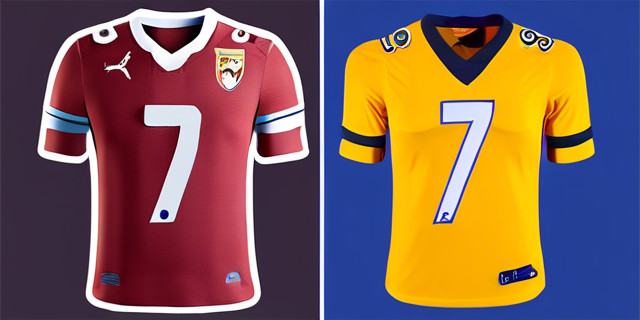How to Spot a Fake Football Jersey: A Complete Guide

Introduction
Football jerseys are an essential part of every fan’s collection. Whether you’re representing your favorite club or national team, wearing an authentic jersey is a statement of pride. However, with the rise of counterfeit jerseys flooding the market, many fans struggle to tell the difference between real and fake jerseys.
Buying a fake jersey not only means lower quality, but it also takes away from the teams and brands that design them. In this guide, we’ll teach you how to spot a fake football jersey so you can buy with confidence at The Aurax.
1. Check the Price: Too Good to Be True?
One of the biggest giveaways of a counterfeit jersey is the price. Official jerseys from top brands like Nike, Adidas, and Puma typically range between $70 to $180 depending on whether they are replicas or authentic player-issue kits.
🔹 How to Spot a Fake Based on Price:
✅ Authentic jerseys from official club stores, trusted retailers, and brands always maintain standard pricing.
❌ Fake jerseys are often sold for $20 to $50, a fraction of the original cost.
💡 Pro Tip: If a deal looks too good to be true, it probably is. Always compare the price with the official store before purchasing.
2. Inspect the Club or Brand Logo
Every authentic jersey will have a high-quality embroidered, stitched, or heat-pressed logo from the club and manufacturer. Fake jerseys often have low-quality printing or incorrect logo designs.
🔹 What to Look For:
✅ Authentic jerseys have crisp, clear logos with no misspellings.
❌ Fake jerseys may have blurry, off-center, or incorrectly shaped logos.
✅ Official jerseys have embroidered club badges or heat-pressed logos with high durability.
❌ Fake jerseys may have cheap plastic badges that peel off after washing.
💡 Pro Tip: If possible, compare the logo with an official jersey from the team’s store to check for differences.
3. Material and Fabric Quality
A real football jersey is made with high-quality materials that are lightweight, breathable, and sweat-wicking. Fake jerseys often use cheap polyester that feels rough or heavy.
🔹 How to Identify Based on Material:
✅ Official jerseys use Nike’s Dri-FIT, Adidas’ AEROREADY, or Puma’s dryCELL technology to keep you cool.
❌ Fake jerseys use thicker, lower-quality fabric that feels uncomfortable or stiff.
✅ Authentic jerseys have ventilation panels for breathability.
❌ Fake jerseys feel plastic-like and don’t have proper ventilation holes.
💡 Pro Tip: If the jersey feels heavy or uncomfortable, it’s likely a fake.
4. Compare the Tags and Labels
Every genuine football jersey comes with a brand label, authenticity tag, and proper care instructions. Counterfeit sellers often ignore small details in the labeling.
🔹 What to Look For in the Tags:
✅ Official jerseys have a hologram or NFC chip verifying authenticity.
❌ Fake jerseys often have missing tags or incorrect font and spelling errors.
✅ Authentic jerseys have club-specific inside labels with washing instructions.
❌ Fake jerseys have poor-quality prints that fade easily.
💡 Pro Tip: Always check the care label inside the jersey—fakes often have generic or poorly printed instructions.
5. Sponsor Printing and Font Accuracy
Many football jerseys come with sponsor logos on the front. Official jerseys have high-quality, long-lasting prints, while fake jerseys often have cheap sticker-like logos that peel off.
🔹 Things to Check:
✅ Authentic jerseys have smooth, heat-pressed sponsor logos.
❌ Fake jerseys often have thicker, rubber-like logos that feel sticky or rough.
✅ Official player names and numbers are printed in club-specific fonts.
❌ Fake jerseys often have incorrect or generic fonts for player names.
💡 Pro Tip: Look at an official version of the jersey online and compare the sponsor’s size, color, and position with what you’re buying.
6. Examine the Stitching and Seams
One of the easiest ways to tell a fake jersey apart is by looking at the stitching quality. Official jerseys are carefully stitched with strong seams, while fakes often have loose threads or poor sewing.
🔹 How to Spot Fake Stitching:
✅ Authentic jerseys have even, secure stitching that lasts through washes.
❌ Fake jerseys have messy, uneven stitching that may come apart easily.
✅ Official kits have reinforcement stitching on high-stress areas like the collar and sleeve cuffs.
❌ Fake jerseys feel cheaply made, with frayed edges or uneven seams.
💡 Pro Tip: Gently pull on the seams—if they start coming apart easily, it’s a fake.
7. Look for the Official Hologram or Serial Number
Brands like Adidas, Nike, and Puma include holograms, serial numbers, or NFC chips to verify authenticity.
🔹 How to Identify an Authenticity Mark:
✅ Nike jerseys come with an NFC chip inside the tag that you can scan with your phone.
✅ Adidas jerseys have a unique hologram sticker that changes under light.
✅ Puma jerseys have a special heat-pressed badge near the bottom hem.
❌ Fake jerseys rarely have these security features or may have low-quality imitation stickers.
💡 Pro Tip: Always check for these authenticity markers before buying.
8. Buy from Trusted Sellers
The best way to avoid fake jerseys is to buy from official stores or trusted retailers like The Aurax.
🔹 Where to Buy Authentic Jerseys:
✅ Official Club Stores: (e.g., Real Madrid Store, Manchester United Megastore)
✅ Trusted Retailers: (e.g., Adidas, Nike, Puma, The Aurax)
✅ Licensed E-commerce Stores: (e.g., The Aurax, Kitbag, Pro Direct Soccer)
❌ Avoid:
- Random social media sellers with no reviews.
- Marketplaces with unusually low prices.
- Street vendors selling “authentic” jerseys at discounts.
💡 Pro Tip: Always check for customer reviews and ratings before purchasing online.
Conclusion
With so many fake jerseys in the market, it’s important to know how to spot the difference between real and counterfeit kits. Here’s a quick checklist before you buy:
✅ Check the price—if it’s too cheap, it’s likely fake.
✅ Inspect the logo—real jerseys have clear, high-quality club and brand logos.
✅ Feel the fabric—official jerseys use high-performance, lightweight material.
✅ Check the sponsor logo—authentic kits have smooth, heat-pressed prints.
✅ Look at the stitching—fake jerseys often have poor-quality seams.
✅ Verify authenticity tags—real jerseys have holograms or serial numbers.
By following these steps, you’ll be able to confidently buy authentic football jerseys from The Aurax and avoid low-quality fakes.
💡 Looking for 100% genuine jerseys? Browse our latest collection at The Aurax today!

